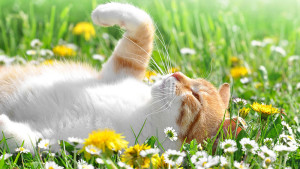Lilies and Cats: A Toxic Combination
March 1st, 2017
Spring will be soon arriving in the Seattle area, bringing with it beautiful blossoms budding all around us. Flowers will make their way into our homes. The flavored flower around Easter time is the beautiful, but toxic, lily. Sadly, people have lost their beloved pet cats to lily toxicity.
Lilies and Cats: The Toxic Flower 
Many cat owners are unaware of the danger that lilies pose to their furry loved ones. When assessing if the lily you have is toxic, keep an eye out for the scientific name of the plant. Dangerous lilies come from the genus Lilium (Lilium sp.), which include Easter, Tiger, and Asiatic lilies and any lily from the genus Hemerocallis (Hemerocallis sp.), which include day lilies. Small ingestions of any part of the plant are highly toxic to your cat. Just three petals or leaves, the pollen, or even the water from the vase can result in acute kidney failure or death. Other dangerous lilies include the Calla or arum lilies (Zantedeschia aethiopica), peace lilies (Spathiphyllum sp.), and lily of the valley (Convallaria majalis).
For a full list of toxic plants, visit the American Society for the Prevention of Cruelty to Animals’ (ASPCA) website.
Veterinary Care in Kirkland
If you notice any of the symptoms below, call our veterinary clinic at 425-636-8201 immediately! We will do our best to make your loved one feel better because “we are all about cats!” Also, there is a Pet Poison Helpline available at 855-764-7661 or visit them here.
Symptoms of lily ingestion include:
- drooling
- vomiting (look out for pieces of the plant)
- loss of appetite
- increased urination, followed by lack of urination after 1-2 days
- dehydration
Calla or arum lilies and peace lilies have crystals which irritate the digestive tract and mouth of your feline friend. Symptoms will include drooling, vomiting and diarrhea, however, they do not affect the kidneys. Lily of the Valley has no effect on the kidneys but instead targets your cat’s heart. This type of plant can cause an irregular heartbeat, low blood pressure and can progress to seizures or a coma.
If possible, bring a piece of the toxic flower, or, more importantly, the plant tag from the plant that your cat ingested to help Dr. Lester diagnose the reaction faster, minimizing long-term organ damage. If you notice that your cat nibbled on a lily and has not vomited, call us at 425-636-8201. Please note, any ingestion of any plant can cause similar symptoms.
Feline Preventative Care in Kirkland
The best way to keep your cat purr-fectly safe from the toxic flower is to avoid lilies altogether. In addition, keep your family members and neighbors informed.
In the Kirkland, WA area, All About Cats Veterinary Hospital will provide the best care for your furry friends. We offer the services you need to keep your cat healthy and active, from preventative care and vaccines to senior wellness care! We would be happy to answer any questions and help in any way we can!
Recent Posts
-
Summer Safety Tips for Cat Owners
July 11th, 2024
-
The ABCs of Cat Vaccinations – What Every Cat Owner Should Know
June 5th, 2024
-
Preparing for Travel With or Without Your Feline Friend
May 3rd, 2024
-
How to Feed Cats in a Multiple-Cat Household
April 8th, 2024
-
8 Tips to Get Your Cat in a Carrier
March 5th, 2024
-
Help, My Cat’s Breath Smells!
February 5th, 2024
-
A Quick Guide to Coping with Cat Emergencies
January 8th, 2024
-
Traveling for the Holidays? 6 Things to Do Before Leaving Your Cat
December 14th, 2023
-
What Is Catnip and Is It Safe for Your Cat?
November 2nd, 2023
-
5 Tips for New Cat Owners
October 5th, 2023
-
How Often Should My Cat Have a Health Check?
September 7th, 2023
-
Cat Hairballs – What Do I Need to Know?
August 4th, 2023
-
How to Play with Your Cat: Fun Cat Activities
July 4th, 2023
-
What to Know About Your Cat’s Surgery
June 10th, 2023
-
Licensed Veterinary Technician or Technician Assistant Wanted (Full time or Part time)
May 15th, 2023
-
Why, Oh Why, Does My Cat Hate Water?
May 9th, 2023
-
What’s Wrong with My Cat? Benefits of Whole-Body Radiology
April 5th, 2023
-
Should I Feed My Cat a Grain-Free Diet?
March 6th, 2023
-
Smelly Cat, Smelly Cat – Causes of Feline Odors
February 22nd, 2023
-
5 Ways to Reduce Cat Shedding
January 3rd, 2023
-
Your Cat’s Holiday Stress – How to Help
December 6th, 2022
-
Pet Cancer Awareness Month: Warning Signs to Look Out For
November 2nd, 2022
-
10 Halloween Safety Tips for Cat Owners
October 3rd, 2022
-
Why Is My Cat So Active at Night?
September 7th, 2022
-
Should I Really Microchip My Cat?
August 9th, 2022
-
Ways to Keep Your Cat Safe and Cool This Summer
July 1st, 2022
-
10 Fascinating Facts About Persian Cats
June 1st, 2022
-
How to Correctly Transition Cat Foods
May 6th, 2022
-
What Your Cat’s Tail Is Secretly Trying to Tell You
April 5th, 2022
-
6 Common Household Items That Are Poisonous to Cats
March 1st, 2022
-
How Do I Know if My Cat Needs Dental Surgery?
February 16th, 2022
-
How to Safely Introduce Your Cat to Your New Baby
January 11th, 2022
-
Giving a Cat as a Christmas Gift: How to Do It Responsibly
December 6th, 2021
-
5 Thanksgiving Foods That Are Toxic to Cats
November 5th, 2021
-
Is My Kitty Depressed? Signs to Look For in a Sad Cat
October 7th, 2021
-
Training Tips for New Kitten Owners
September 7th, 2021
-
Taking Your Cat to the Vet: How to Make It a Stress-Free Experience
August 6th, 2021
-
The Origins and History of the Tabby Cat
July 13th, 2021
-
We are hiring a Veterinary Technician!
July 12th, 2021
-
Kitty Claw Control: How and When to Cut Your Cat’s Nails
June 7th, 2021














